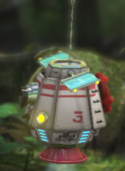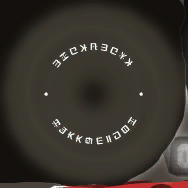SPERO: Difference between revisions
AeroBlaze777 (talk | contribs) m (→Trivia: "it is most likely is") |
(Expansion.) |
||
| Line 1: | Line 1: | ||
{{game icons|p3=y}} | {{game icons|p3=y}} | ||
[[File:SPERO2.png|thumb|125px|A SPERO.]] | [[File:SPERO2.png|thumb|125px|A SPERO.]] | ||
The '''SPEROs''' | The '''SPEROs''' are intergalactic unmanned probes built and launched by the [[Koppai]]tes. Their function is to search out planets that harbor edible matter; in the case of the Koppaites, this means [[fruit]]. Many SPEROs were built, yet only one of the last few dispatched actually managed to find [[PNF-404|a planet]] with suitable food. | ||
Besides being plot points, SPEROs serve a purpose in [[Mission Mode]]. They are used as a storage device for the [[fruit]]s, treasures and [[enemies]] collected in [[Collect Treasure!]] stages, comparable to the [[Hocotate ship|ship's]] Research Pod in underground areas in ''[[Pikmin 2]]''. Besides that, it can collect [[Burgeoning Spiderwort]] berries and bring [[Louie]] back to consciousness when he is carried to one, meaning that it can appear in Battle Enemies! stages as well. It has no other functions, however. | |||
==Locations== | |||
As stated above, a SPERO appears in all Collect Treasure! stages in [[Mission Mode]], near the starting point. It also appears in the following Battle Enemies! stages: | |||
*[[Tropical Wilds Remix]], at the starting point | |||
*[[Garden of Hope Remix]], at the starting point | |||
*[[Fortress of Festivity]], slightly to the north of the starting point | |||
*[[Beastly Caverns]], at the center, near the blue Onion | |||
*[[Forgotten Cove]], at the center, near the Master Onion | |||
*[[Clockwork Chasm]], at the starting point | |||
==Naming== | |||
"SPERO" is pronounced like "[[wikipedia:Sparrow|sparrow]]", as proven by the introduction [[cutscene]] in {{p3}}. Because the name is written in all caps, it is most likely an acronym, albeit an unknown one. Interestingly, SPERO also means "I hope" in Italian. Given the probes' mission, it seems fitting. | |||
==Gallery== | ==Gallery== | ||
<gallery> | <gallery> | ||
SPERO.png|A picture of a SPERO from Mission Mode. | |||
SPEROs.png|SPEROs searching for other planets with edible food for Koppai, from the game's introduction [[cutscene]]. | SPEROs.png|SPEROs searching for other planets with edible food for Koppai, from the game's introduction [[cutscene]]. | ||
Pikmin 3 SPERO artwork.jpg|Official art of the SPERO from one of Nintendo's magazines. | Pikmin 3 SPERO artwork.jpg|Official art of the SPERO from one of Nintendo's magazines. | ||
</gallery> | </gallery> | ||
==Trivia== | ==Trivia== | ||
[[File:SPERO texture text.png|thumb|200px|Part of the SPERO's texture, showing the Koppaite text.]] | |||
* | *The lens frame at the front of the SPERO has [[Koppaite text]] on it that reads "Automatic Ultrascope". This is a reference to the Automatic Ultra Scope, the Japanese name of a toy periscope released by Nintendo in 1971.<ref>[http://blog.beforemario.com/2011/06/nintendo-automatic-ultra-scope-ultra.html beforemario's blog post on the Automatic Ultra Scope]</ref> The text is too small to read normally, but can be seen on the device's texture. | ||
==See also== | ==See also== | ||
*[[Hocotate ship]] | *[[Hocotate ship]] | ||
*[[Mission Mode]] | *[[Mission Mode]] | ||
==References== | |||
{{refs}} | |||
[[Category:Ships]] | [[Category:Ships]] | ||
Revision as of 11:31, October 28, 2015
The SPEROs are intergalactic unmanned probes built and launched by the Koppaites. Their function is to search out planets that harbor edible matter; in the case of the Koppaites, this means fruit. Many SPEROs were built, yet only one of the last few dispatched actually managed to find a planet with suitable food.
Besides being plot points, SPEROs serve a purpose in Mission Mode. They are used as a storage device for the fruits, treasures and enemies collected in Collect Treasure! stages, comparable to the ship's Research Pod in underground areas in Pikmin 2. Besides that, it can collect Burgeoning Spiderwort berries and bring Louie back to consciousness when he is carried to one, meaning that it can appear in Battle Enemies! stages as well. It has no other functions, however.
Locations
As stated above, a SPERO appears in all Collect Treasure! stages in Mission Mode, near the starting point. It also appears in the following Battle Enemies! stages:
- Tropical Wilds Remix, at the starting point
- Garden of Hope Remix, at the starting point
- Fortress of Festivity, slightly to the north of the starting point
- Beastly Caverns, at the center, near the blue Onion
- Forgotten Cove, at the center, near the Master Onion
- Clockwork Chasm, at the starting point
Naming
"SPERO" is pronounced like "sparrow", as proven by the introduction cutscene in Pikmin 3. Because the name is written in all caps, it is most likely an acronym, albeit an unknown one. Interestingly, SPERO also means "I hope" in Italian. Given the probes' mission, it seems fitting.
Gallery
- SPERO.png
A picture of a SPERO from Mission Mode.
SPEROs searching for other planets with edible food for Koppai, from the game's introduction cutscene.
Trivia
- The lens frame at the front of the SPERO has Koppaite text on it that reads "Automatic Ultrascope". This is a reference to the Automatic Ultra Scope, the Japanese name of a toy periscope released by Nintendo in 1971.[1] The text is too small to read normally, but can be seen on the device's texture.



